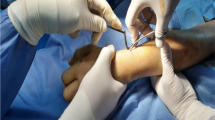Abstract
This study aimed to evaluate the effect of manipulation under anaesthesia (MUA) and Kirschner wire (K-wire) fixation of displaced, paediatric distal radius fractures on residual radiological angulation, displacement, and shortening, as well as functional outcomes, including complication rates. A retrospective review was conducted of all paediatric patients undergoing MUA and K-wire fixation for an extra-articular distal radius fracture over a period of 5 years. A total of 248 patients were included in the study with a mean age of 9.9 years (3–15). Mean follow-up was 6.6 weeks (4–156). There was a statistically significant increase in median dorsal angulation (p < 0.0001) between initial post-operative and follow-up radiographs at the time of K-wire removal. The number of K-wires used did not have a significant effect on dorsal angulation (p = 0.9015) at time of K-wire removal, nor did the use of an above or below elbow cast (p = 0.3883). Seventeen patients required a further general anaesthetic (5 revision operations, 12 removal of migrated K-wires). Eighty-seven percentage of (215 patients) of patients had normal function at follow-up post-K-wire removal. Angulation at time of K-wire removal of more than 15° was significantly associated with reduced functional outcome (p = 0.0377). A total of 41 patients (17 %) had complications associated with K-wire use. We conclude that though K-wire fixation is an effective technique, it does not prevent re-angulation of the fracture and is associated with a significant complication rate. Given the remodelling potential and tolerance to deformity in children, surgeons should give careful thought before utilising this technique for all displaced or angulated paediatric distal radius fractures. If used, 1 K-wire with immobilisation in a below elbow cast is sufficient in most cases.


Similar content being viewed by others
References
Cheng JCY, Shen WY (1993) Limb fracture pattern in different pediatric age groups: a study of 3350 children. J Orthop Trauma 7:15–22
Devalia KL, Asaad SS, Kakkar R (2011) Risk of redisplacement after first successful reduction in pediatric distal radius fractures: sensitivity assessment of casting indices. J Pediatr Orthop B 20(6):376–381
Miller BS, Taylor B, Widmann RF, Bae DS, Synder BD, Waters PM (2005) Cast immobilisation versus percutaneous pin fixation of displaced radial fractures in children: a prospective, randomised study. J Paediatr Orthop 25:490–494
Colaris JW, Allema JH, Reijman M, Biter LU, de Vries MR, van de Ven CP, Bloem RM, Verhaar JA (2013) Risk factors for the displacement of fractures of both bones of the forearm in children. Bone Joint J 95-B(5):689–693
Alemdaroğlu KB, Iltar S, Cimen O et al (2008) Risk factors in redisplacement of distal radial fractures in children. J Bone Joint Surg Am 90-A:1224–1230
Sankar WN, Beck NA, Brewer JM, Baldwin KD, Pretell JA (2011) Isolated distal radial metaphyseal fractures with an intact ulna: risk factors for loss of reduction. J Child Orthop 5(6):459–464
Jordan RW, Westacott DJ (2012) Displaced paediatric distal radius fractures–when should we use percutaneous wires? Injury 43(6):908–911
Monga P, Raghupathy A, Courtman NH (2010) Factors affecting remanipulation in paediatric forearm fractures. J Pediatr Orthop B 19:181–187
Bohm ER, Bubbar V, YongHing K, Dzus A (2006) Above and below-the-elbow plaster casts for distal forearm fractures in children. A randomized controlled trial. J Bone Joint Surg Am 88(1):1–8
Webb GR, Galpin RD, Armstrong DG (2006) Comparison of short and long arm plaster casts for displaced fractures in the distal third of the forearm in children. J Bone Joint Surg Am 88(1):9–17
Hove LM, Brudvik C (2008) Displaced paediatric fractures of the distal radius. Arch Orthop Trauma Surg 128(1):55–60
Crawford SN, Lee LS, Izuka BH (2012) Closed treatment of overriding distal radial fractures without reduction in children. J Bone Joint Surg Am 94(3):246–252
McLauchlan GJ, Cowan B, Annan IH, Robb JE (2002) Management of completely displaced metaphyseal fractures of the distal radius in children: a prospective, randomised controlled trial. J Bone Joint Surg Br 84-B:413–417
Proctor MT, Moore DJ, Paterson JMH (1993) Redisplacement after manipulation of distal radial fractures in children. J Bone Joint Surg 75-B:454
Choi KY, Chan WS, Lam TP, Cheng JC (1995) Percutaneous Kirschner-wire pinning for severely displaced distal radial fractures in children. A report of 157 cases. J Bone Joint Surg Br 77(5):797–801
Gartland JJ Jr, Werley CW (1951) Evaluation of healed Colles’ fracture. J Bone Joint Surg Am 33:895–907
MacDermid JC, Turgeon T, Richards RS, Beadle M, Roth JH (1998) Patient rating of wrist pain and disability: a reliable and valid measurement tool. J Orthop Trauma 12:77–86
Conflict of interest
None.
Author information
Authors and Affiliations
Corresponding author
Rights and permissions
About this article
Cite this article
Ramoutar, D.N., Shivji, F.S., Rodrigues, J.N. et al. The outcomes of displaced paediatric distal radius fractures treated with percutaneous Kirschner wire fixation: a review of 248 cases. Eur J Orthop Surg Traumatol 25, 471–476 (2015). https://doi.org/10.1007/s00590-014-1553-6
Received:
Accepted:
Published:
Issue Date:
DOI: https://doi.org/10.1007/s00590-014-1553-6




